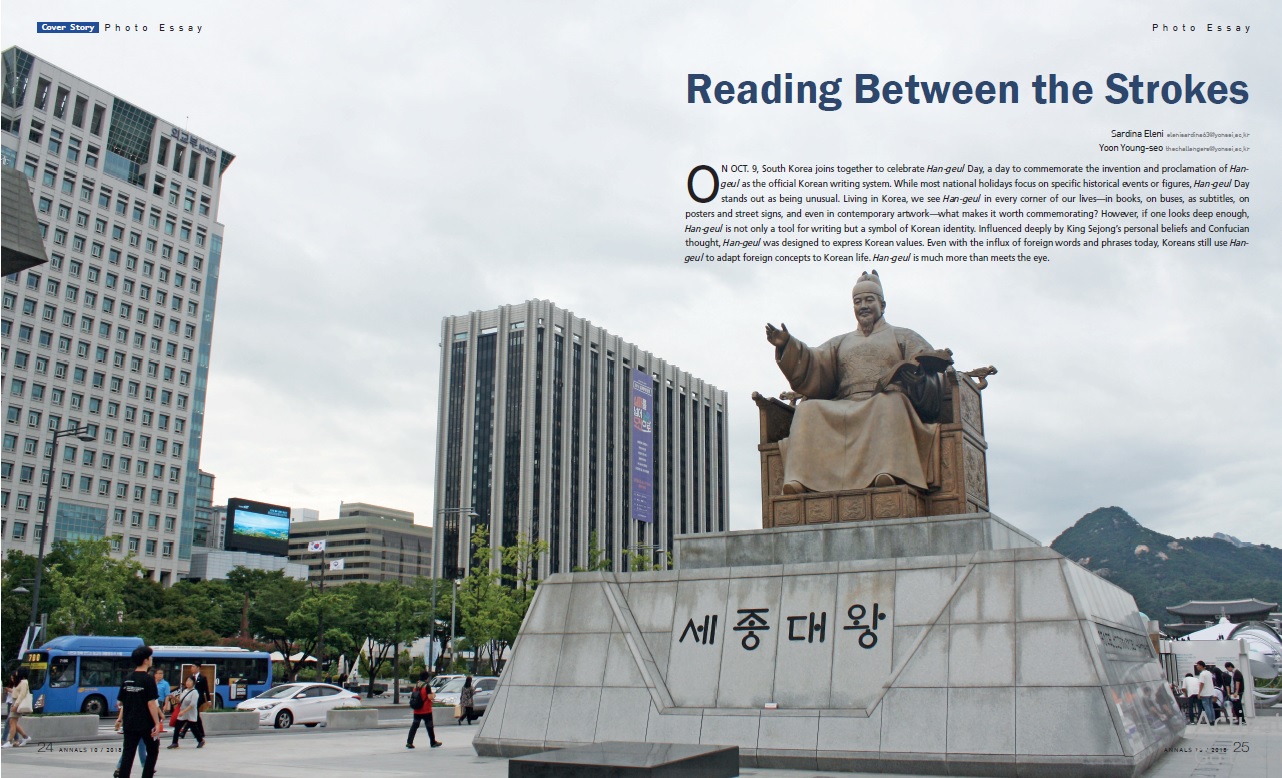
ON OCTOBER 9, South Korea joins together to celebrate Han-geul Day, a day to commemorate the invention and proclamation of Han-geul as the official Korean writing system. While most national holidays focus on specific historical events or figures, Han-geul Day stands out as being unusual. Living in Korea, we see Han-guel in every corner of our lives—in books, on buses, as subtitles, on posters and street signs, and even in contemporary artwork—what makes it worth commemorating? However, if one looks deep enough, Han-geul is not only a tool for writing but a symbol of Korean identity. Influenced deeply by King Sejong’s personal beliefs and Confucian thought, Han-geul was designed to express Korean values. Even with the influx of foreign words and phrases today, Koreans still use Han-geul to adapt foreign concepts to Korean life. Han-geul is much more than meets the eye.
Han-geul began its journey in the mind of King Sejong. According to the Annals of King Sejong, he “from the beginning enjoyed his teachings, was not lazy, and always had a book in his hand.” This image is not too far off from the statue of him in Gwanghwamun Plaza, located in the center of Seoul, where he sits upon a throne, wearing a gentle expression and holding an open book in one hand.
Han-geul incorporates the most important facet of his political beliefs: a people-oriented philosophy. According to the King’s philosophy as inspired by the teachings of Mengzi, the heart of his regime was his people*. Before the invention of Han-geul, the use of Chinese characters was the most prevalent system of writing that dominated Korea. However, its usage was largely restricted to the wealthy upper-class. To address this inequality, King Sejong developed a new set of characters that was easier to learn and was more accessible to the civilians. Han-geul is the living reflection of King Sejong’s egalitarian principles and his determination to keep peace and order, something South Koreans still hold dearly until this day.
Han-geul has deeper roots than just King Sejong’s political philosophy, having direct inspiration from the Confucian concept of yin and yang**. Within the Hun min jeong eum, the first publication that explains Han-geul'’s significance, King Sejong explained how the appearance of the Han-geul characters themselves reflect Confucian values. The vowels’ composition consists of three elements that represent a part of the universe: the dot as the heaven and the yang, the vertical stroke as the man, and the horizontal stroke as the earth and the yin. Just like the elements of the universe come together to create a balanced harmony, the strokes of Han-geulcome together to create a harmonized sound.
While the inspiration of Han-geul is centuries past,Han-geul Day’s various events and activities allow Koreans to tap back into its origins. The National Han-geul Museum engages its visitors in a holistic experience of celebrating Han-geul, from its humble beginnings to its various applications in modern art. The most innovative part of the museum is its Han-geul playground, where children and their parents gather to learn the history and structure of Han-geul. Small children jump around on Han-geul-shaped cushions, while parents and older children sit inside rocket-shaped structures to play games on interactive screens. The Museum also holds unique exhibits such as Dictionaries of Korea, A New Perspective. Near the exit of these various exhibits are collections of notes that the visitors have left behind, displaying various forms of Korean handwriting expressing gratitude and appreciation for Han-geul after their tour of the meaningful venue.
Another place to visit on Han-geul Day is the Sejong Story Exhibit, located in the Gwanghwamun Square underneath the bronze statue of King Sejong. The exhibit illustrates the aesthetic beauty of the Han-geulcharacters amidst modern office buildings. In this way, it embodies the yin and yang harmony of tradition and modernity.
Inside the exhibit is a modern facility with a maze-like structure, which fills the visitors with fascination as it visually depicts the story of Han-geul. Benches and art displays are decorated with calligraphy as visitors sit under the dim lighting, murmuring amidst themselves surrounded by the hypnotizing swirl of characters.
* * *
With each stroke, Han-geul characters come alive to tell a story, not that of the writer, but of Han-geul'’s creation and harmony. Using Han-geul every day presents us an opportunity to appreciate written Korean culture as a piece of art.
*Encyclopedia of Korean Culture
**Yin and yang: A Chinese philosophy which describes the yin and the yang as opposite yet complementary forces bringing balance to the universe
Sardina Eleni, Yoon Young-seo
thechallengers@yonsei.ac.kr

